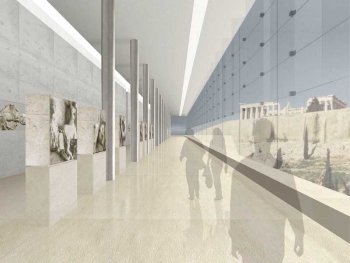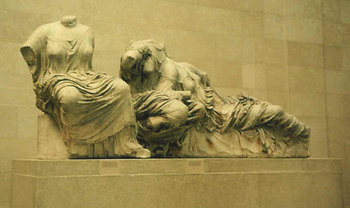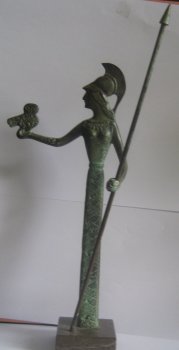Acropolis Museum and New Acropolis Museum.
Both these museums were closed while we were in Athens. No, I see no cause and effect in this. Just luck.
Preparations were well advanced to begin moving artifacts from the Acropolis Museum on the Sacred Rock to the New Acropolis Museum. On our next to last day the first trials began with the huge cranes dotted around the site.
For the Acropolis Museum
http://odysseus.culture.gr/h/1/eh151.jsp?obj_id=3392

For the New Acropolis Museum
http://en.wikipedia.org/wiki/New_Acropolis_Museum

However, we walked by the latter one afternoon and Kate asked a gentleman on a gate when it would open, and he said it is open. Well, not quite. An annex in an old building next door has a display about the building of the New Acropolis Museum, because here, as everywhere else in Athens, once the shovel hits, artefacts turn up. So the New Museum will be built with a glass floor to show the remains found below.
It is a small exhibition and as I walked around concentrating mostly on the story of building, I walked past a bust. I stopped, for some reason, and went back: Plato. A Roman copy of the first century A.D. Since no photographs were allowed I cannot tender evidence.
When walking around ruins I thought about Lord Elgin several times. He found the Acropolis in ruins during the Turkish Occupation. He recognized the value of what he saw, and what he saw first were the broken remnants on the ground. He asked for permission to box these up and got. That emboldened him to go for more. The guidebooks now adopt a tone of high moral dungeon about this but I am not sure. At that time and place, a reasonable person might well have concluded that the rest would soon enough be torn down and used to build a mole at Piraeus or a damn in the mountains. Too bad he did not get there earlier and spirit away either of the statues of Athena (one inside the buliding and one outside) to preserve it. Without an Elgin to save them, both of these statutes are completely lost. Probably broken up for the precious metals and stones, and the rest used as firewood and building material for sheds.

They are remarkable works, finished in equal detail on the back as on the front. Though they would only ever be viewed from the front, they were finished on the back to please the gods. That is perfectionism!
Nor am I so sure about repatriation now, though Greeks have no doubts. If all artefacts have to go home, close all the museums and bring in the vans. Greek museums that we visited have artefacts from Turkey, Bulgaria, Iran, and Iraq, like the Islamic Art in the Benaki Museum Annex in the Plaka, and I doubt if market price was paid for all of them to the rightful owner. There are also other objects from Egypt that were probably stolen two millennia ago by soldiers of Alexander. Why is the Kyklades Museum in Athens and not in the Kyklades? And of course Greece plants its flag on islands and territories, including Cyprus, claimed by Bulgaria, Turkey, Albania, FYROM, and others as a result of being on the Allied side at the end of World War II. Where do these arguments end?
I notice that the Greek argument is no longer nationalism: they are ours, give them back which was the argument for a long time.
Now the argument is a curator’s one: collect all the artefacts in one place: ours.
Whatever conclusion one reaches, there is no doubt that the New Acropolis Museum is brilliantly conceived and executed to make the point of the absent objects and their origins on the Sacred Rock.
Since neither museum was open we had no chance to Visa through these two museum shops. Get it, “to Visa?” At the foot of the Acropolis is small shop, about the size of U-Haul Rental trailer. It was a hot day and stuffy inside with a bored clerk reading a magazine. There were a few miniature reproductions, calendars, and book marks. No Greek neck ties. No owls. That’s it. No sale. We did not even face this minor temptation on the grounds of the New Acropolis Museum. The shops we saw in musuems were usually not tempting. The noteworthy exceptions were the Kyklades Museum and the Benaki Museum which both summoned the Visa cards.
By the way we saw plenty of owls in Athens, so many it was hard to choose, though I broke through the contradictions and chose one with Athena consulting the owl.

But we saw few owls in the museum shops. Rather they were in the souvenir shops, which we felt we had a responsibility to assess, inverting objects to look for the “Made in China” stickers, say on the Christmas ornaments. Though Kate espied some bobbles for Christmas that were not stamped out of a factory in China and we acquired same.
